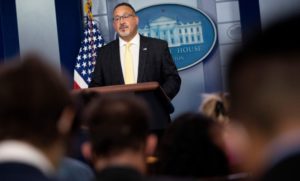
The Justice Department sues Arizona over voting restriction, President Biden announces an updated rule for union pension plans, and more…
IN THE NEWS
- The U.S. Department of Justice filed a lawsuit against the state of Arizona challenging a voting law that requires Arizona voters to provide proof of citizenship before voting in federal elections. The Justice Department alleged that the Arizona law violates provisions of the National Voter Registration Act of 1993 and the Civil Rights Act of 1964. Assistant Attorney General Kristen Clarke of the Justice Department’s Civil Rights Division said that the Arizona law “turns the clock back on progress by imposing unlawful and unnecessary requirements that would block eligible voters from the registration rolls for certain federal elections.” The state law, passed in March 2022, could prevent 31,500 people who vote only in federal elections in Arizona from voting in the 2024 presidential election.
- President Joseph R. Biden announced an updated rule governing the Special Financial Assistance (SFA) program that will allow some multiemployer, union-based pension plans to apply for additional government funding. These multiemployer plans were projected to become insolvent by 2026, threatening the retirement security of over three million American workers, retirees, and their families. The SFA’s updated rule will allow for the government to provide an estimated $74 to $91 billion in special financial assistance, which will enable eligible multiemployer plans to continue paying full retirement benefits to pensioners until 2051.
- New Jersey Governor Phil Murphy signed seven new gun regulations into law. These laws, which Governor Murphy described as being based on “common sense,” include a mandate that individuals complete firearm training to obtain gun permits and a requirement that new residents register their firearms within 60 days of moving to the state. Opponents argued that the legislative effort—a third package of gun regulations New Jersey has enacted since 2018—unfairly burdens “law-abiding citizens.” The Giffords Law Center ranked New Jersey second on its list of states with the strongest gun regulations.
- The U.S. Department of the Interior announced an upcoming public comment period for a proposed program through which the federal government leases public lands to oil and gas companies. The program would help the Interior Department determine how many, if any, areas it will make available for offshore oil and gas drilling between 2023-2028. In developing the plan, the Interior Department considered industry interest and the distribution of environmental risks among the regions that would be affected. Drew Caputo, vice president of litigation at the environmental advocacy group Earthjustice, described the proposal as “a failure of climate leadership.”
- The U.S. Department of Education released proposed regulations that would lift the student debt burden for students who are disabled, whose schools closed, and who have met their commitments under the Department’s Public Service Loan Forgiveness Among other changes, the proposed regulations would prohibit colleges from requiring borrowers to sign class action waivers and eliminate strict limits on when borrowers can file a claim against a school that allegedly defrauded or otherwise took advantage of them. U.S. Secretary of Education Miguel Cardona explained that the proposed regulation is part of the Biden Administration’s commitment to building a “more accessible, affordable, and accountable student loan system.”
- The Federal Communications Commission (FCC) announced updates to a proposed rule aimed at enhancing cellular network resiliency in the face of natural disasters and other emergencies by mandating several previously voluntary measures.. If adopted, this proposed rule would expand the time and locations in which carriers can roam on each other’s networks during disasters, promote cellular service continuity during disaster-related disruptions, and facilitate mutual aid among wireless providers in emergencies. FCC Chairwoman Jessica Rosenworcel said that this action “will help restore service faster, help speed response coordination, and keep more people connected in disaster.”
- The U.S. Department of Health and Human Services (HHS) and the Centers for Medicare & Medicaid Services (CMS) proposed a rule that would establish certain conditions that rural emergency hospitals must meet to participate in Medicare and Medicaid programs. Rural emergency hospitals were established in 2020 to provide care to areas most severely affected by health care inequities. In addition, rural emergency hospitals are designed to address the growing issue of rural hospital closures due to a lack of the patient volume necessary to sustain the level of services required to maintain Medicare funds. The proposed conditions would include transfer agreements with trauma centers and adaptation of relevant skilled nursing facility requirements. HHS and CMS intend the proposed conditions to elevate the medical capabilities of these hospitals and facilitate access to quality hospital care for rural Americans who are often impacted by poverty and have limited access to health care.
- The U.S. Department of Labor terminated the Trade Adjustment Assistance for Workers Program, which was established in 1974 to provide assistance to workers who lost or were at risk of losing their jobs due to global trade. The program offered training, case management, income support, job search allowances, and relocation allowances to workers. The program’s statutory authorization under the Trade Act of 1974 expired on June 30, 2022, once the program’s termination provision went into effect. Secretary of Labor Marty Walsh said that the termination affects 100,000 workers who depend on the program’s assistance, and he emphasized that “only Congress” can reauthorize the program.
WHAT WE’RE READING THIS WEEK
- In a Columbia Law Review article, Alexis Karteron, associate professor and director of the Constitutional Rights Clinic at Rutgers Law School, outlined the “shadow system of family separation” that results from criminal conviction. Karteron examined common parole conditions that lead to family separation, such as limitations on parolees’ associations with people who have been or are incarcerated and prohibitions against contact with children for parolees convicted of sex offenses. Karteron concluded that the “conditions render thousands of families subject to correctional control long after incarceration has ended.” Karteron argued that these cases should invoke heightened scrutiny—requiring courts to balance individual and state interests rather than defer to supervision authorities—since they implicate familial integrity rights.
- In an article in the University of Chicago Law Review, Daniel Hemel, then a professor at the University of Chicago Law School, explored whether cost-benefit analysis in policy evaluation should account for income distribution. Hemel noted that rising income and wealth inequality in the U.S. has made arguments for incorporating distributive consequences into cost-benefit analysis more compelling. Hemel explained that one method, distributionally weighted cost-benefit analysis, applies greater weights to costs and benefits incurred by lower-income individuals or groups. Yet Hemel defended the typical method of cost-benefit analysis, which does not take income into account because it “makes practical sense for U.S. federal agencies.” Specifically, Hemel argued that distributionally weighted cost-benefit analysis imposes a heavier informational burden on federal agencies by requiring the determination of the distribution of dollar gains and losses and the magnitude of those dollar gains and losses.
- In an article in the Yale Journal on Regulation, Justin Gundlach, senior attorney at the Institute for Policy Integrity at New York University School of Law, and Michael A. Livermore, director of the Program in Law, Communities, and the Environment at the University of Virginia Law School, explored two methods of calculating the harm caused by greenhouse gases when considering policy changes. Gundlach and Livermore debated the comparative benefits of using the “social cost of carbon,” which represents, in monetary terms, the harms caused by greenhouse gas emissions, versus the “marginal abatement costs,” which represent the costs of reducing the last unit of pollution under an emissions reduction policy. Gundlach and Livermore argued that, on the one hand, in circumstances where weighing the net benefits to the public welfare of adopting a particular policy is important, the social cost of carbon should be used to measure the estimated welfare impacts of climate change. On the other hand, Gundlach and Livermore contended that marginal abatement costs would be the better choice when a regulation seeks a specified outcome and there are multiple viable solutions because they consider the cost-effectiveness of each alternative. Gundlach and Livermore posited that both metrics can be useful tools, and regulators should employ either one whenever appropriate.
EDITOR’S CHOICE
- In an essay in The Regulatory Review, Max Sarinsky, senior attorney at the Institute for Policy Integrity at New York University School of Law, and Peter Howard, economics director at the Institute for Policy Integrity at New York University School of Law, argued that limiting fossil fuel extraction reduces climate pollution. Sarinsky and Howard urged the Biden Administration to take an evidence-based approach to fuel substitution in overhauling its federal fossil-fuel leasing program. Sarinksy and Howard noted that when the Trump Administration rolled back policies aimed at curbing emissions, it weakened international efforts to address climate change.



